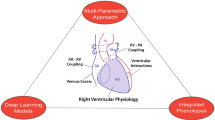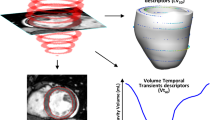Abstract
The aim of the present work was to study the reliability of conductance microcatheter volumetric measurements as compared to magnetic resonance imaging (MRI) in the same set of mice. Mice left ventricular (LV) volumes were monitored under basal conditions and in a hypertrophy model induced by transverse aortic constriction (TAC). Cardiac function was evaluated in isoflurane anesthetized mice (n = 8) by MRI followed by 1.4 F Millar microtip catheter measurements. The second group of mice with TACinduced cardiac hypertrophy was studied eight weeks after surgery. Reliability of 3D–reconstructed MRI data was confirmed by comparison with autopsy masses (autopsy LV mass = 73.6 ± 3.4 mg; MRI LV mass = 76.9 ± 3.7 mg). Conduction catheter was found to greatly underestimate end–diastolic and end–systolic volumes and thus stroke volume as well as cardiac output in control mice (MRI: EDV = 79 ± 8 µl, ESV = 27±9 µl, SV = 51 ± 9 µl, CO = 25 ± 6 ml/min; Catheter: EDV = 28 ± 5 µl, ESV = 8 ± 4 µl, SV = 19 ± 4 µl, CO = 10 ± 2 ml/min). However, values for ejection fraction showed no significant differences between the two methods. In the hypertrophy model, stroke volume and cardiac output were increased when measured with MRI (SV: +19 ± 20%; CO: +28 ± 27%), whereas catheter data showed opposite directional changes (SV: –22 ± 37%; CO: –31 ± 37%). Ejection fraction was found to be reduced only in catheter measurements (–31 ± 26%). In summary, our data demonstrate that absolute volumetric values are strikingly underestimated by conduction catheter measurements and that even detection of directional changes with this method may not always be feasible.
Similar content being viewed by others
References
Baan J, van der Velde ET, de Bruin HG, Smeenk GJ, Koops J, van Dijk AD, Temmerman D, Senden J, Buis B (1984) Continuous measurement of left ventricular volume in animals and humans by conductance catheter. Circulation 70:812–823
Burkhoff D, van der Velde ET, Kass D, Baan J, Maughan WL, Sagawa K (1985) Accuracy of volume measurement by conductance catheter in isolated, ejecting canine hearts. Circulation 72:440–447
Dawson D, Lygate CA, Saunders J, Schneider JE, Ye X, Hulbert K, Noble JA, Neubauer S (2004) Quantitative 3–dimensional echocardiography for accurate and rapid cardiac phenotype characterization in mice. Circulation 110:1632–1637
Feldman MD, Erikson JM, Mao Y, Korcarz CE, Lang RM, Freeman GL (2000) Validation of a mouse conductance system to determine LV volume: comparison to echocardiography and crystals. Am J Physiol Heart Circ Physiol 279:H1698–H1707
Georgakopoulos D, Mitzner WA, Chen CH, Byrne BJ, Millar HD, Hare JM, Kass DA (1998) In vivo murine left ventricular pressure–volume relations by miniaturized conductance micromanometry. Am J Physiol 274:H1416–H1422
Haase A, Frahm J, Matthaei D, Hanicke W, Merboldt KD (1986) Flash imagingrapid NMR imaging using low flip–angle pulses. Journal of Magnetic Resonance 67:258–266
Ito H, Takaki M, Yamaguchi H, Tachibana H, Suga H (1996) Left ventricular volumetric conductance catheter for rats. Am J Physiol 270:H1509–H1514
Lembo G, Rockman HA, Hunter JJ, Steinmetz H, Koch WJ, Ma L, Prinz MP, Ross J Jr, Chien KR, Powell–Braxton L (1996) Elevated blood pressure and enhanced myocardial contractility in mice with severe IGF–1 deficiency. J Clin Invest 98:2648–2655
Lips DJ, van der NT, Steendijk P, Palmen M, Janssen BJ, van Dantzig JM, de Windt LJ, Doevendans PA (2004) Left ventricular pressure–volume measurements in mice: comparison of closed–chest versus open–chest approach. Basic Res Cardiol 99:351–359
Reyes M, Freeman GL, Escobedo D, Lee S, Steinhelper ME, Feldman MD (2003) Enhancement of contractility with sustained afterload in the intact murine heart: blunting of length–dependent activation. Circulation 107:2962–2968
Rockman HA, Ross RS, Harris AN, Knowlton KU, Steinhelper ME, Field LJ, Ross J Jr, Chien KR (1991) Segregation of atrial–specific and inducible expression of an atrial natriuretic factor transgene in an in vivo murine model of cardiac hypertrophy. Proc Natl Acad Sci USA 88:8277–8281
Ruff J, Wiesmann F, Hiller KH, Voll S, von Kienlin M, Bauer WR, Rommel E, Neubauer S, Haase A (1998) Magnetic resonance microimaging for noninvasive quantification of myocardial function and mass in the mouse. Magn Reson Med 40:43–48
Schneider JE, Cassidy PJ, Lygate C, Tyler DJ, Wiesmann F, Grieve SM, Hulbert K, Clarke K, Neubauer S (2003) Fast, highresolution in vivo cine magnetic resonance imaging in normal and failing mouse hearts on a vertical 11. 7 T system. Journal of Magnetic Resonance Imaging 18:691–701
Siri FM, Jelicks LA, Leinwand LA, Gardin JM (1997) Gated magnetic resonance imaging of normal and hypertrophied murine hearts. Am J Physiol 272:H2394–H2402
Slawson SE, Roman BB, Williams DS, Koretsky AP (1998) Cardiac MRI of the normal and hypertrophied mouse heart. Magn Reson Med 39:980–987
Tao W, Deyo DJ, Traber DL, Johnston WE, Sherwood ER (2004) Hemodynamic and cardiac contractile function during sepsis caused by cecal ligation and puncture in mice. Shock 21:31–37
Wiesmann F, Neubauer S, Haase A, Hein L (2001) Can we use vertical bore magnetic resonance scanners for murine cardiovascular phenotype characterization? Influence of upright body position on left ventricular hemodynamics in mice. J Cardiovasc Magn Reson 3:311–315
Wiesmann F, Ruff J, Engelhardt S, Hein L, Dienesch C, Leupold A, Illinger R, Frydrychowicz A, Hiller KH, Rommel E, Haase A, Lohse MJ, Neubauer S (2001) Dobutamine–stress magnetic resonance microimaging in mice: acute changes of cardiac geometry and function in normal and failing murine hearts. Circ Res 88:563–569
Wiesmann F, Ruff J, Hiller KH, Rommel E, Haase A, Neubauer S (2000) Developmental changes of cardiac function and mass assessed with MRI in neonatal, juvenile, and adult mice. Am J Physiol Heart Circ Physiol 278:H652–H657
Yang B, Larson DF, Watson R (1999) Agerelated left ventricular function in the mouse: analysis based on in vivo pressure– volume relationships. Am J Physiol 277:H1906–H1913
Author information
Authors and Affiliations
Corresponding author
Additional information
Drs. Jacoby and Molojavyi contributed equally to this work.
Rights and permissions
About this article
Cite this article
Jacoby, C., Molojavyi, A., Flögel, U. et al. Direct comparison of magnetic resonance imaging and conductance microcatheter in the evaluation of left ventricular function in mice. Basic Res Cardiol 101, 87–95 (2006). https://doi.org/10.1007/s00395-005-0542-7
Received:
Revised:
Accepted:
Published:
Issue Date:
DOI: https://doi.org/10.1007/s00395-005-0542-7




